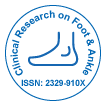当社グループは 3,000 以上の世界的なカンファレンスシリーズ 米国、ヨーロッパ、世界中で毎年イベントが開催されます。 1,000 のより科学的な学会からの支援を受けたアジア および 700 以上の オープン アクセスを発行ジャーナルには 50,000 人以上の著名人が掲載されており、科学者が編集委員として名高い
。オープンアクセスジャーナルはより多くの読者と引用を獲得
700 ジャーナル と 15,000,000 人の読者 各ジャーナルは 25,000 人以上の読者を獲得
インデックス付き
- Google スカラー
- シェルパ・ロミオ
- Jゲートを開く
- アカデミックキー
- レフシーク
- ハムダード大学
- エブスコ アリゾナ州
- OCLC-WorldCat
- パブロン
- ジュネーブ医学教育研究財団
- ユーロパブ
- ICMJE
役立つリンク
オープンアクセスジャーナル
このページをシェアする
抽象的な
Peripheral Talus Fractures-A Clinical Observational Study of 16 Cases
Christina Roll, Bernd Kinner
Background: Peripheral talar fractures are rare injuries. They comprise fractures of the lateral process, the lateral and medial tubercle of the posterior process, the medio-caudal ridge, and traumatic osteochondral fractures of the lateral talar dome. The objective of this observational case series was to report the clinical and radiological outcome after surgical treatment.
Methods: 16 peripheral talar fractures could be included in this retrospective case series. All patients were treated operatively and followed for a minimum of 12 months. Clinical and radiological outcome were recorded.
Results: Mean follow-up was 16 months. 13 subjects presented with concomitant injuries. 2 patients suffered an additional spine fractures, and 4 patients were polytraumatized. No non-union or mal-union were observed. One patient needed subtalar and calcaneo-cuboidal fusion during follow up due to a concomitant calcaneal fracture. Other secondary procedures like implant removal were necessary in 5/16 subjects. During the last follow-up the recorded AOFAS score (mean ± SD) was 87.3 ± 6.6 and the EQ5-D (mean ± SD) 0.91 ± 0.06.
Conclusion: With early diagnosis and timely surgical treatment good results can be expected after peripheral fractures of the talus. Less favourable outcomes are usually associated with concomitant injuries.

 English
English  Spanish
Spanish  Chinese
Chinese  Russian
Russian  German
German  French
French  Portuguese
Portuguese  Hindi
Hindi